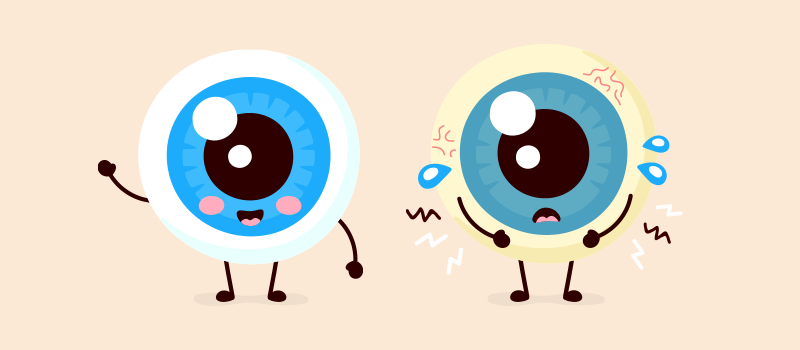What’s the Buzz
The Bee Healthy Blog
Best Eye Drops After Cataract Surgery

A cataract is a clouding of the lens in the eye that is often related to aging. Some 25 million people in the United States had cataracts in 2010, and this number is expected to double to 50 million by 2050. The only effective treatment for cataracts is surgery, which involves removing the clouded lens and replacing it with an artificial one. This surgery is an outpatient procedure with no hospital stay required.
Cataract surgery is generally safe. Your recovery should be short and uneventful as long as you follow your doctor’s post-operative instructions and keep your follow-up appointment. One of the instructions you will receive following cataract surgery is the use of eye drops. So, which eye drops are best to use after cataract surgery?
What kind of eye drops are used after cataract surgery?
Your eye doctor will give you one or more prescription eye drops to use after cataract surgery. These eye drops serve different purposes—some decrease inflammation, others prevent infection, and some provide postoperative relief from redness, dryness, and itching.
Some of the common classes of eye drops prescribed after cataract surgery include:
- Steroid eye drops - They relieve pain and inflammation, such as prednisolone 1%. You may need to use these for a few days or up to a month after your cataract surgery.
- Antibiotic eye drops - They are used to prevent infection. The surgeon makes cuts in the eye during the surgery. While this is done under sterile conditions, there is still a risk of infection. Examples of antibiotic eye drops are ofloxacin (Ocuflox, Floxin) and gatifloxacin (Besivance, Vigamox, and Zymaxid). You may need to use them for a few weeks after your surgery.
- NSAID (non-steroidal anti-inflammatory drugs) eye drops - They are given to treat pain, swelling, and inflammation after cataract surgeries. Examples of this type of eye drop are ketorolac and nepafenac.
It is worth noting that while there are many over-the-counter eye drops that can effectively relieve common eye symptoms such as dry eye, redness and irritation, they are only intended for everyday use. You should use the eye drops prescribed by the ophthalmologist after your cataract surgery. The reason for that is prescription eye drops specifically treat the after-effects of cataract surgery and pack a little more punch than their over-the-counter cousins. Following your doctor’s instructions, including using eye drops as directed after cataract surgery, can help you feel better sooner and speed up your recovery.
What are the best eye drops for dry eyes after cataract surgery?
Dry eye is commonly seen in people over the age of 55. Cataracts typically occur in older individuals, who may already have some symptoms of dry eye. It is also typical for symptoms of dry eye to first appear after cataract surgery. Here’s what leads up to it.
An unstable tear film
The most common cause of dry eye is an unstable tear film. This results in the ocular surface becoming temporarily dry. With age, the quality of the tear film diminishes. After cataract surgery, the eyelid constantly rubs against the tiny incision from the surgery when you blink, leading to irritation and scratchiness.
Artificial tears can provide relief
Artificial tears are over-the-counter eye drops that can provide relief from dry eye symptoms. They lubricate the eye and augment the natural tear film. Artificial tears are available without prescription and can be used several times a day. The additional ocular surface lubrication provided by artificial tears can provide comfort after cataract surgery.
After the prescription eye drops have been tapered, some people develop dry eye. This is because some prescription eye drops provide supplemental lubrication. If this should occur, you can use the over-the-counter artificial tears for a few months after your surgery to improve comfort.
Keep in mind that you can actually overuse artificial tears; this is a fact that a lot of people are unaware of. Artificial tear overuse can cause your natural tears to be washed out. For artificial tears with preservatives, you do not want to use them more than four to six times a day. The good news is there are preservative-free artificial tears available over-the-counter. Typically, you can use these as frequently as needed. However, it is best that you talk to your optometrist or ophthalmologist first; they will be able to choose the best product for you and give you advice on how to use it appropriately.
How long do you have to put drops in your eyes after cataract surgery?
Patients need to use eye drops several times daily for the first week after cataract surgery. These are slowly tapered off. Depending on how much inflammation you have, you may need the eye drops for a few weeks to a few months. It is important to follow the postoperative eye care instructions from your ophthalmologist to ensure a smooth recovery and maintain good long-term eye health.
Is it safe to use Systane after cataract surgery?
Systane is a prescription ophthalmic solution that is specially formulated to prevent various signs and symptoms of an unstable tear film. Systane moistens the eyes, thus, relieving dry eye symptoms such as irritation, burning, and discomfort. This product is superior to other traditional eye drops because it binds to the tears to form a gel-like film, offering long-lasting relief. It is safe to use Systane as a soothing eye drop after cataract surgery.
Choosing the right eye drops after cataract surgery
Always follow eye drop recommendations from your ophthalmologist after cataract surgery to avoid complications. You might feel tempted but do not self-treat since it can cause you more harm than good. However, there are certain things to keep in mind when choosing eye drops.
Many eye drops contain preservatives. These chemicals prolong the shelf life of the medicine. However, while the preservatives keep the product contamination-free, they can sting your eyes, which can be very uncomfortable after cataract surgery. Therefore, it may be beneficial to choose preservative-free eye drops. These eye drops come in sterile, single-use containers that are equally effective.
Eye drops that contain antihistamines can reduce redness following surgery. However, they may not be a good choice after cataract surgery because they make the blood vessels in the eye narrower. Why is it not a good choice? Because just like any other organs and body parts, you would need adequate blood flow to heal properly after surgery. Also, antihistamine eye drops can sting the eyes.
Compared to solution-based eye drops, gel-based eye drops stay longer in the eyes, thus, providing longer-lasting relief. However, they can cause blurry vision when first applied, so you will need to exercise caution while using them.
Safe use of eye drops after cataract surgery
For a safe and speedy recovery after cataract surgery, follow these tips on using eye drops:
- Ensure your hands are clean by washing them thoroughly with soap and water—you will touch some parts of your eye when putting the eye drops in.
- Sit or lie down comfortably. If sitting, tilt your head back.
- Gently pull the lower eyelid down and brace your hand against your forehead or the bridge of your nose for stability.
- Squeeze a drop into the eye, close your eye, blink, and close your eye again.
- Do not touch the tip of the bottle to the eye - this can lead to contamination.
- Blot away excess fluid with a tissue.
- If you have to put in several eye drops, wait 5 to 10 minutes before applying the next one.
References:











SOCIAL